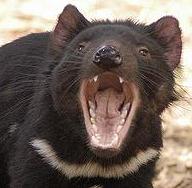 根據澳洲國家環境法,澳洲的標誌性本地物種、世界上仍存活的最大肉食有袋動物--袋獾,5月22日從易危物種改列為瀕危等級。這項由澳洲環境部長賈瑞特(Peter Garrett)宣佈的措施,意味著袋獾會在國家環境法下得到更多的保護。他說此擧是解決袋獾持續受到威脅、數量不斷下降的方法。
根據澳洲國家環境法,澳洲的標誌性本地物種、世界上仍存活的最大肉食有袋動物--袋獾,5月22日從易危物種改列為瀕危等級。這項由澳洲環境部長賈瑞特(Peter Garrett)宣佈的措施,意味著袋獾會在國家環境法下得到更多的保護。他說此擧是解決袋獾持續受到威脅、數量不斷下降的方法。
賈瑞特指出,「在受威脅物種科學委員會(TSSC)建議之下,我決定把袋獾列為瀕危物種。該委員會舉出面部腫瘤疾病是威脅袋獾的主因。1996年初次發現這種疾病以來,已導致袋獾數量減少了約70%。同時,該致命癌症看來是透過動物間互咬而直接傳染。」
他說「政府已承諾,未來五年投下1千萬美元的經費在拯救袋獾計劃上,協助疾病傳播和治療的研究,並照顧圈養和野生袋獾。」
這些食肉有袋動物一度遍佈澳洲全國和沿海的島嶼,但現在只有在塔斯馬尼亞島上才有袋獾的蹤跡。
塔斯馬尼亞袋獾保護區坐落於塔斯馬尼亞東南部,距離荷巴特(Hobart)約一小時的車程,是唯一一個隔離無疫情地區内的野生動物中心。該中心成立於1978年,是世界上第一個袋獾中心。中心除了鼓勵遊客近距離體驗袋獾外還參與各項研究,找出治療疾病的辦法。
由於袋獾是夜行性動物加上狡猾的個性,因此很難得見到它們曝露在無遮蔽的野生環境中。另外,袋獾的頜骨非常有力,以覓食和交配季節期間的兇狠攻擊行為著稱。
志工旅行方案、以7種語言進行野外旅遊導覽,都是保護公園經過大改造之後新推出的壓軸活動。新計劃在6月中旬墨爾本舉行的澳洲旅遊交易展(ATE)中與國際旅遊業者見面。
公園的創始人和主任Hamilton稱「我們創新的多種語言導覽除了帶領遊客深入袋獾的世界,同時目睹園内最先進的保護措施。我們不僅僅扮演拯救瀕危袋獾的重要角色,更朝著成為一個21世紀示範野生動物中心的目標邁進。」
澳洲是60-70萬物種的棲息地,其中約84%生長在大陸上的植物、83%的哺乳動物和45%的鳥類唯獨澳洲才有。
One of Australia's iconic native species and the world's largest surviving marsupial carnivore was today reclassified as closer to extinction under Australia's national environment law.
Environment Minister Peter Garrett announced that the Tasmanian devil now will be listed as Endangered instead of Vulnerable. Garrett said the uplisting means the species is under continued threat and the population is continuing to decline and also that the species will get greater protection under national environment law.
"My decision to uplist the Tasmanian devil is based on advice from the Threatened Species Scientific Committee which lists the devil facial tumour disease as the major threat to the devil," said Garrett. "This disease has led to the decline of about 70 percent of the Tasmanian devil population since the disease was first reported in 1996." The invariably fatal cancer appears to be passed directly from animal to animal by biting.
The minister said. "The Australian Government has already committed $10 million over five years to the Save the Tasmanian Devil program. This is to help with research into disease transmission and treatment, and will support captive and wild populations."
Now found only on the island of Tasmania, these meat-eating marsupials once roamed widely across Australia and on islands around the coast.
Tasmanian Devil Conservation Park in southeast Tasmania about an hour from Hobart is the only wildlife center in an isolated disease-free area. Established in 1978 as the world's first Tasmanian devil center, the park is involved in research to help solve the disease problem, while encouraging visitors to experience the presence of Tasmanian devils.
Seeing a Tasmanian devil in the wild is difficult as they are nocturnal creatures with a furtive nature. Devils have strong jaws and are famous for their snarling aggressive behavior at feeding and mating times.
New conservation voluntourism programs, new wildlife tours and interpretation in seven languages are key parts of a radical makeover at Tasmanian Devil Conservation Park.
The new programs will be introduced to the international travel industry at the Australian Tourism Exchange in Melbourne in mid-June.
"Our innovative multilingual interpretation will take visitors deeply into the world of the devil while also addressing cutting edge conservation," said park founder and director John Hamilton. "We are aiming to be a yardstick for 21st century wildlife centers while at the same time playing a major role in saving the endangered Tasmanian devil。"
Australia is inhabited by between 600,000 and 700,000 species, many of which are found nowhere else in the world. About 84 percent of the continent's plants, 83 percent of mammals, and 45 percent of birds are only found in Australia.





